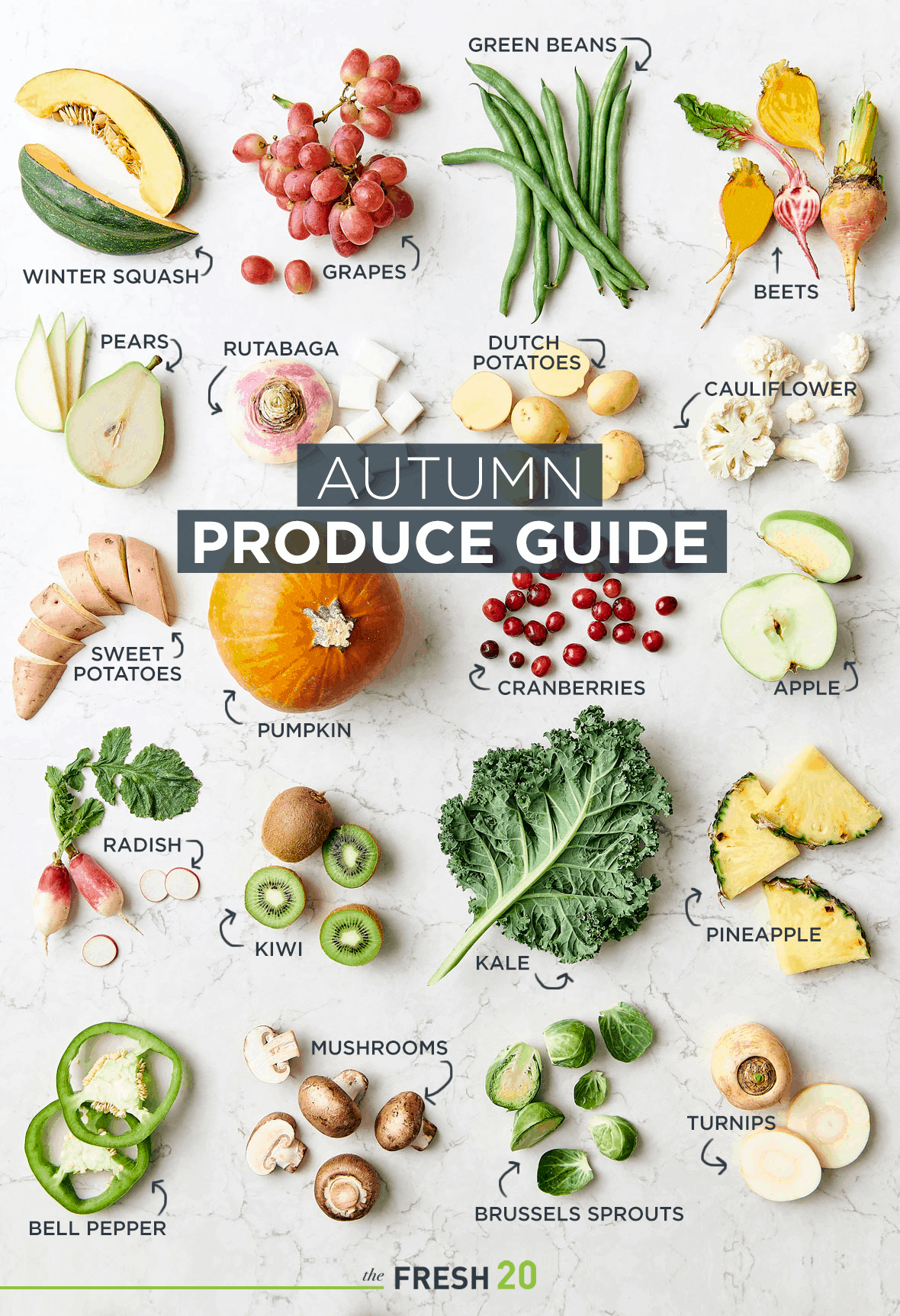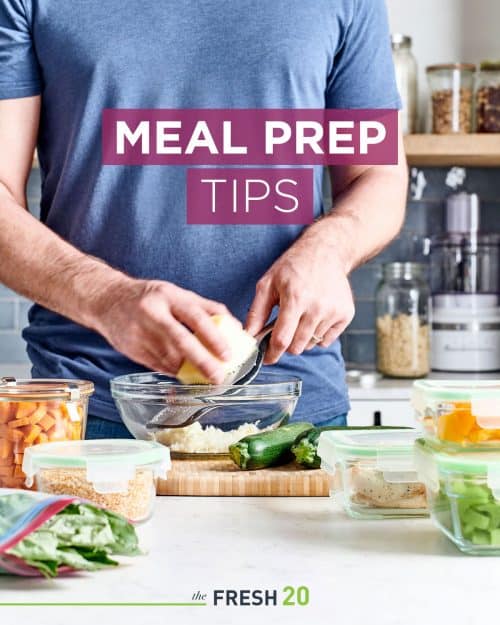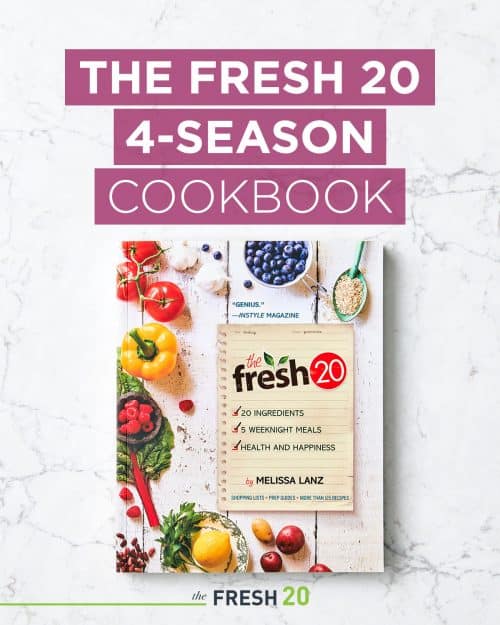The Best Seasonal Produce for Autumn
Looking for all the best tips for selecting and preparing fall fruits and vegetables? The Fresh 20 Fall Produce Guide to seasonal fruits and vegetables is here!

Fall Produce Guide
Eating seasonally isn’t just beneficial to your health, it’s more sustainable and better for the earth. This reference guide breaks down how to choose, store and cook fall produce.
WINTER SQUASH
They are low in calories, high in fiber and Vitamin A, and have a unique sweet nutty flavor. Roasting brings out the best flavors, so when possible use this simple cooking method. When selecting your squash, choose a heavy squash with unblemished skin and dry, intact stem. With the seeds contained in the round bottom, the neck of the squash is full of delicious meat – so choose a wider neck over a thin one.
GRAPES
Packed with antioxidants and vitamin K, grapes make a delicious and healthy snack. Look for plump grapes with a green, flexible stem. They’re the perfect compliment to salads with nuts and seeds, and dressed with tangy vinaigrette.
GREEN BEANS
One of the most common and kid friendly fall produce vegetables is green beans. Green beans are high in fiber, vitamins, calcium, potassium, and iron. Known as string beans, snap beans, or Haricot Verts, green beans are the young unripe fruit and pod of bean plants. While there are over 100 varieties ranging from green to yellow to purple, the key to green beans popularity is their versatility and mild flavor. The can be quickly blanched and served with other cold veggies, or they can be boiled, sautéed, roasted, or added to soups and stews. To store, put unwashed beans in a plastic bag or container and store in the crisper for up to a week. To use simply trim any dry or browned ends and snap into bite sized pieces!
BEETS (BEETROOT)
No Fall Produce Guide would be complete without beets. Packed with essential nutrients, beetroots are a great source of fiber, folate (vitamin B9), manganese, potassium, iron, and vitamin C. Beetroots and beetroot juice have been associated with numerous health benefits, including improved blood flow, lower blood pressure, and increased exercise performance.
PEARS
It’s okay. Give that pear a little squeeze. It should give a little so you know it’s ripe. If it’s soft, leave it on the shelf. Pears are an extremely versatile fruit used in baking and cooking.
RUTABAGA
Root vegetables, as the name implies, are literally the roots of a plant. They are a good source of complex carbohydrates and are high in fiber and Vitamins A and C. Most common are carrots, potatoes, parsnips, radishes, and beets. Because they grow underground they absorb their vitamins and minerals from the earth. However, they can also absorb toxins from the soil so organic is the best choice. If your market sells root veggies with the stems still attached choose ones that look bright and fresh. At home store your root veggies in a cool, dark place with some humidity – in the refrigerator in a paper or plastic bag will keep them crisp and crunchy.
DUTCH POTATOES
Dutch potatoes are small and round with gold skin and creamy white flesh. They have a naturally buttery and nutty flavor, and cook beautifully when grilled, roasted, steamed, sautéed, or boiled making them a great fall vegetable with lots of variety. Look for potatoes with smooth skin with no greening or sprouting. Store in a cool well ventilated area.
CAULIFLOWER
If you haven’t tried roasting cauliflower you will be delighted with the rich, nutty flavor that can be developed with just a bit of oil and a hot oven. Low in calories with tons of vitamin c, fiber and protein, cauliflower is a nutritional powerhouse! While we mostly see it in white, cauliflower comes in a variety of beautiful colors such as green, orange, and even purple. Preparation is easy, just remove the outer leaves and any discolored spots then trim the florets off where they meet the stalks.
SWEET POTATOES
When shopping for sweet potatoes choose potatoes that are firm and without any obvious bruises or soft spots. The larger the potatoes get the higher the starch content so stick with the size the recipe calls for. Be sure to make use of that scale in the produce section to be sure you are getting the correct amount of potatoes for your recipe – a single large potato can weight up to 3/4 pound! When properly stored, sweet potatoes have a long shelf life so be sure to keep them in a cool, dry, dark place.
SWEET POTATOES VS. YAMS
Are sweet potatoes and yams the same thing? No! The two root vegetables are not the same, and are not even closely related. Most US grocery stores carry sweet potatoes which have a thin orange/rust colored skin and are usually a rich orange color inside. A true yam has a muddy brown, bark-like skin and white flesh and is much drier and starchier than a sweet potato. If you can’t track down a true yam, you can substitute russet potatoes.
PUMPKIN
The ultimate fall produce! While the monster sized pumpkins are fantastic for carving, they aren’t really suited for cooking. For the best flavor and texture, choose those small, deep orange pumpkins labeled ‘sugar ‘ or ‘pie’ pumpkins. At around 2-3 pounds, their flesh is dense and sweet without the stringy, watery strands you find in carving pumpkins. To prepare them for soups and chili, just remove the skin, cut in half, and scoop out seeds. After you cut them in cubes toss with olive oil, salt, and pepper and roast to bring out that delicious, unique flavor. Enjoy!
CRANBERRIES
Cranberries are loaded with more antioxidants than other every day berry varieties like strawberries and blueberries. What they don’t contain is much sugar, which is why they taste bitter. This is why they’re typically cooked into jams and sauces. They’re delicious added to slow cooker pot roast or to make your own cran-apple juice.
APPLES
Of course, this fruit is going to be included in a Fall Produce Guide. Apples are a staple available all year but they are at their peak from late September to early December. With hundreds of varieties to chose from most people stay close to the popular Fuji, Granny Smith and Honeycrisp. Look for apples with tight skins and no bruises.
RADISH
Radishes frequently show up as a garnish in restaurants in interesting and unexpected colors and shapes. The common cherry-red marble-sized radish contains a degree of heat produced by an enzyme in the skin of the radish. The radish’s name is often derived from this tangy vegetable’s appearance.
Use radishes by finely chopping, then combine with mayonnaise for a tangy relish spread for ham or roast beef sandwiches. Toss sliced radishes with romaine lettuce; top with slivered ham, turkey and pepper jack cheese; drizzle with ranch dressing.
When selecting, look for pieces with good size and color. Pick a radish with firm roots and crisp white flesh. Refrigerate whole in a plastic bag for up to one month. Freezing is not recommended.
KIWI
Native to China and Taiwan, kiwi is actually a berry known for its bright green flesh and furry brown skin. Kiwis have a juicy, slightly tart flavor reminiscent of melon and fresh berries. Kiwis have more Vitamin C than citrus and can be used in marinades as a meat tenderizer. When choosing kiwis, check the skin for bruises or wrinkling, which can show they are overripe. The fruit should have a slight give to gentle pressure. With a very long shelf life, Kiwi can be refrigerated for two or three weeks. If they’re too firm and not quite ripe, you can store them in a paper bag with other fruits such as bananas to speed up ripening. Peel them gently with a spoon and slice them crosswise for a beautiful addition to salads, or scoop the flesh out with a spoon for a snack and to add to smoothies.
KALE
Also referred to as Black, Tuscan and Dino Kale, this Lacinato Kale is actually a dark grey bluish-green, has small, tender leaves when compared to curly green kale. Served uncooked in a salad, this variety has a citrus flavor with notes of pine; when cooked, black kale has a nutty-broccoli taste. This kale is packed with nutrients, though it cooks much quicker then curly kale and is much more subtle as a flavor additive when used in soups or stews. Kale turns sweeter in a light frost, so is most flavorful in fall and winter. Avoid washing kale until just before use since it will hasten spoilage. Always store refrigerated. Considered to be one of the most highly nutritious vegetables, with powerful antioxidant and anti-inflammatory properties. Amazingly, one cup of kale contains 1,300 times the daily requirement of Vitamin K! Red Kale has a much sweeter flavor than its pepper green cousin with more tender leaves. Red kale can be eaten raw in salads or it can be steamed, boiled, or sautéed.
PINEAPPLE
Of all the ingredients in the Fall Produce Guide, pineapple is my absolute favorite! Look for fruit with bright coloring and deep green leaves. Avoid pineapples with brown or soft spots and dry brown leaves. Keep in refrigeration for up to ten days. The texture is soft, the flavor is sweet, and is a wonderful ornamental fruit. Choose pineapples with a sweet aroma and a firm texture. Pineapples have a great shelf life; they should last a week or two.
BELL PEPPER
A cup of red bell pepper contain almost 3 times the vitamin C of an orange (I know, mind-blowing!), making it one of the best veggies to load up on in the Fall and Winter seasons. Bell peppers last 1 to 2 weeks in the refrigerator, and can be cut several days in advance. Remove all seeds and white membranes before you chop. Look for crisp, vibrantly colored peppers with no bruises. They are delicious roasted, sauteed and fresh.
MUSHROOMS
Versatile and inexpensive, mushrooms are a delicious way to add texture and flavor to almost any savory dish. The term ‘button mushroom’ generally refers to the widely available white mushroom. Often smaller white mushrooms are referred to as ‘button’ and the medium 1” size are just called ‘white’ – both sizes have a very mild flavor. The term ‘brown mushroom’ refers to the darker varieties also called ‘cremini’ or ‘baby bellas’ and are the young version of the popular large Portobello mushroom. Brown mushrooms have an earthier flavor and are a great substitute for meat in vegetarian recipes. Mushrooms and moisture are NOT a good mix so be sure to choose ones that are dry (not slimy), firm, smooth, and plump.When you get them home, store unwashed mushrooms in a paper bag in the refrigerator for 2-3 days. To clean, just wipe off dirt with a damp kitchen towel, don’t soak your mushrooms or they will absorb water causing them to steam instead of brown during cooking. If you get an especially dirty batch you can wash gently under running water, but pat them dry before cooking. Before using, cut off any tough stem ends and slice according to recipe directions. Slow cooking allows moisture to evaporate, if you are roasting or sautéing, you may want to drain off any liquid that accumulates.
BRUSSELS SPROUTS
Are they really from Brussels? Originally yes, they are thought to be native to an area near Belgium’s capital of, you guessed it, Brussels. The sprouts are the buds of a form of cabbage plant and grow clustered on a long stalk. Choose smaller heads, about the size of a quarter, they are sweeter. Be sure the heads are tightly closed with no yellow or browning leaves. This much maligned vegetable is an excellent source of Vitamin C – one serving provides half your daily requirement (that’s more than oranges). Overcooking can result in an unpleasant smell so a quick blanch and then sauté on dinner night will provide perfect results. Are your kids reluctant to try Brussels sprouts? Share this fact with them at the dinner table, the world record for eating Brussels sprouts is 31 in one minute, set in 2008. Wow! Check out our CANDIED BRUSSELS SPROUTS RECIPE
TURNIPS
High in fiber, turnips are a root vegetable that are white on the bottom and purple or yellow on top. They are bitter raw, but become sweeter when roasted, similar to carrots. They can also be mashed like potatoes and cauliflower. Turnips should be scrubbed with a brush under running water, prior to use. There is no need to peel or cook if the skin is thin.
The Fall Produce Guide is just a summary of all the amazing fruits and vegetables available in October, November and December. There is so much in season so experiment with something new!!
For more information on what’s in season, check out Melissa’s Produce.











